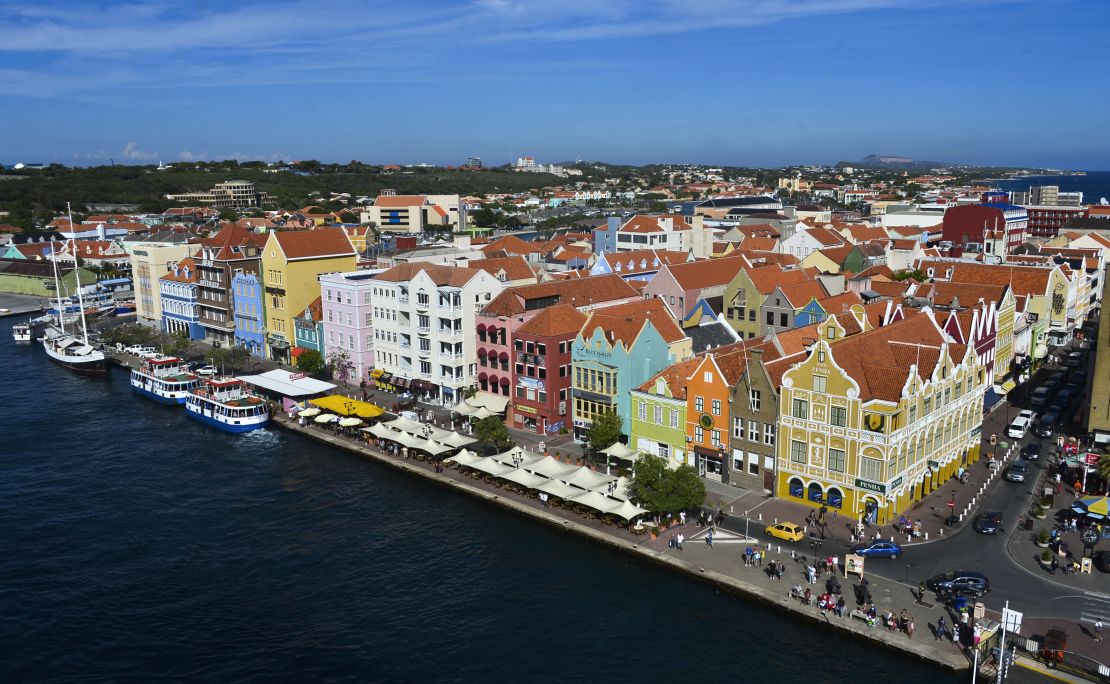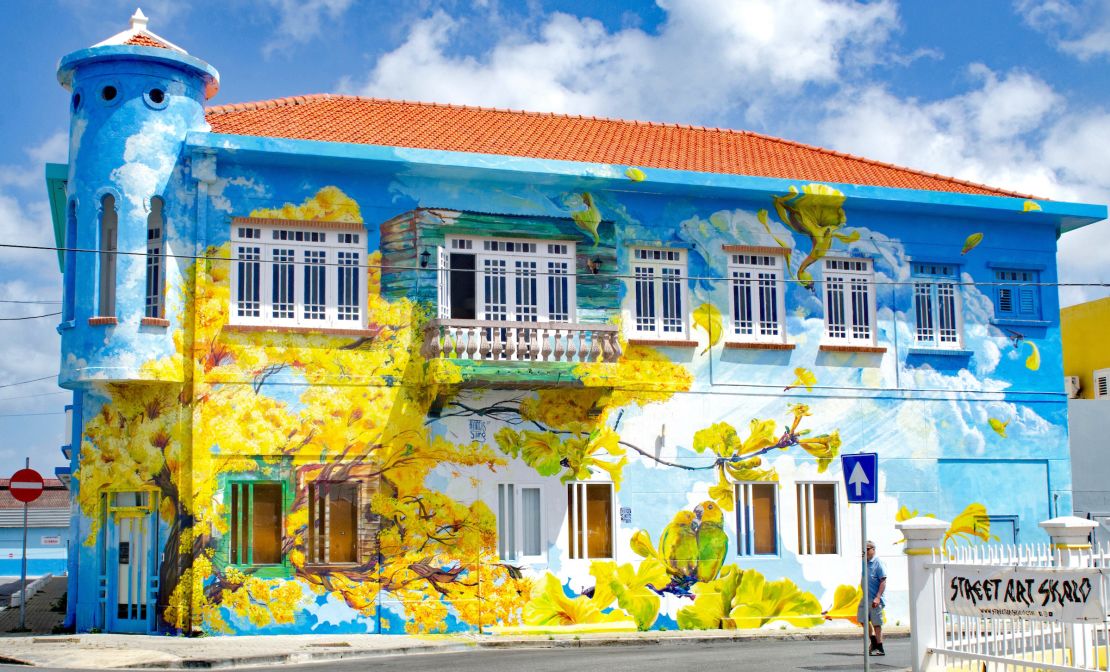Conveniently sitting outside the hurricane belt, just 50 miles east of busy Aruba, laid-back Curaçao boasts vibrant architecture and history, multicultural neighborhoods, white sand beaches and iridescent turquoise Caribbean water.
The island is best known for its capital Willemstad, with its candy-colored Dutch colonial architecture lining a gorgeous bay.
In 2017, the city celebrates 20 years on the UNESCO World Heritage List. But you don’t need to wait until the official date of December 4 to celebrate. There’s a festive mood around the island, with plenty to do and see in Willemstad and beyond.
Here are 13 of the most fun things to do there:
1. Enjoy a culture-filled capital
It’s often described as a mini-Amsterdam, but Curaçao’s capital packs its own Euro-Caribbean punch. Four colonial districts offer distinct experiences:
The cobblestoned alleys of Punda beg for promenades, lined with designer stores, art galleries, museums and alfresco restaurants.
Across the floating Queen Emma Bridge, Otrobanda’s pastel-colored buildings house discount stores, Creole restaurants and dimly lit bars along the Bredestraat, with Latin tunes echoing into the street.

Pietermaai’s trendy lounge scene develops after dark, while Scharloo’s 19th-century mansions and street art attract creative types.
“On December 4, Willemstad formally marks 20 years as a World Heritage City. But we’re celebrating the whole year,” says Marcel Dennert, managing director of Stichting Monumentenzorg, Curaçao’s monuments foundation.
The organization is hosting the third annual Caribbean Conference of National Trusts and Preservation Societies in Willemstad from November 16 to 19, 2017, with guest speakers from around the Caribbean region, including Cuba.
“There’s a lot of excitement. We’re considered the big brother of monument preservation,” said Dennert.
It’s the perfect occasion to sign up and enjoy expert-led, English-speaking architecture tours of Willemstad’s charming colonial neighborhoods. Year-round, Dushi Walks Curaçao offers walking tours of Otrobanda and Scharloo.
8 fun things to do in Nevis now
2. Visit the oldest synagogue in the Americas
Towering over a bistro-lined street, the Mikvé Israel-Emanuel Synagogue – part of the UNESCO designation – is the oldest continually running synagogue in the Americas, in use since 1732.
Nearly 300 years old, the pastel yellow building is impressive for its neoclassical design but also for having a distinctive sand floor. This feature is in part a reminder of the congregants’ ancestors who were secret Jews living in Spain and Portugal during the Inquisition. They were forced to muffle the sounds of their worship, before eventually fleeing to Amsterdam and other countries, and later settling on Curaçao.
Today, the Snoa – short for esnoga, or synagogue in ancient Portuguese – serves 145 families who keep this heritage going. Entrance includes a visit to the adjacent two-story Jewish Cultural Historical Museum housing artifacts, photographs and stories of Curaçao’s Jewish community.
3. Go to wild, natural landscapes
The undeveloped, rugged northeast is where Curaçao really breathes, with two adjacent protected parks.
Christoffel National Park offers multiple trails designed for hiking or for exploration from the comforts of a vehicle. Sunrise safaris allow hikers to skip the heat while spotting the island’s flora and fauna – including the endangered white-tailed deer and the native barn owl.
The intrepid tackle the island’s highest peak early in the day – Mount Christoffel towers over Curaçao at 1,239 feet.
Next door, Shete Boka National Park stretches 10 kilometers along the island’s rockiest coastline, and its deserted beaches are a major turtle-nesting site.
Marked trails along craggy limestone bluffs lead to viewing platforms directly above a series of seven inlets where the sea blasts furiously against the rocks. Boka Pistol is the most impressive inlet of all, with waves shooting up to 40 feet high.
The world’s most beautiful island hotels
4. Taste a rich and flavorful cuisine
Like much of the Caribbean, Curaçao’s diverse cuisine reflects its history and heritage, from Creole to Dutch and Indonesian.
The official dish is keshi yena – cheese stuffed with a spiced meat (often chicken), olives, capers, picked onions and prunes, all baked to perfection. A delicious version is on the menu at Gouverneur de Rouville, set in a second-story colonial building in Otrobanda, with panoramic views of Willemstad’s waterfront.
A popular beverage to beat the heat and wash it all down is awa di lamunchi, a freshly squeezed and sweetened lime juice.
5. Eat from a food truck
Curaçaoans are big on their truki pan – which translates literally, in the local Papiamentu language, as “bread truck.”
The most popular food trucks come out in the Caracasbaai area near Willemstad after 9 p.m., pimped out with flashing disco lights and blaring music, while dishing out perfectly seasoned, grilled meats – from ribs to stuffed sandwiches. Night owls flock to them between or after party hops.
Elite Grill Food is a favorite for its steak, while BBQ Express is legendary for its ribs.
Fruit smoothie and dessert trucks aren’t any less ubiquitous, open during daytime hours – Dushi Wafels in Willemstad’s Punda neighborhood serves traditional Dutch treats like oliebollen and stroopwafel, and batidos vans serve refreshing fresh fruit milkshakes.
6. See African artifacts at the Kurá Hulanda Museum
The Kurá Hulanda Museum boasts the most comprehensive collection of African artifacts in the Caribbean.
It’s also home to a detailed display of the trans-Atlantic slave trade, explaining Curaçao’s role as a prime location where Dutch entrepreneurs sold and shipped enslaved Africans to other parts of the Caribbean and to the United States.
In the Middle Passage building, museum guide Yflen Florentina shares hair-raising tales about the methods of capture and punishment alongside branding tools, cages and iron collars. Steep wooden stairs lead to a dimly lit basement built in the exact measurements and shape of a ship hull, outfitted with shackles, for a troubling glimpse of the conditions in which enslaved Africans were transported.
7. Swim along Westpunt’s enchanting coastline
A favorite weekend escape of locals, the island’s west point is a standout, brimming with beaches lining the crystal-clear Caribbean Sea.
An hour-and-a-half drive from Willemstad, a winding coastal road lined with giant cacti leads toward a seascape of bluffs towering over fine, white sand stretches. Spending days snorkeling and diving right off the cliffs or the beach is an easy task. Corals and tropical fish are abundant, while visibility is almost always perfect.
While many beaches have small entrance fees, Playa Kenepa, the prettiest by far, is a public stretch where coolers are welcome. And snack vendors are lined up at the entrance – a perfect excuse to sample the local pastechi, a crunchy pastry stuffed with seasoned meats.
8. Attend Thursday Punda Vibes
Once a week, Willemstad comes alive with Thursday Punda Vibes. From 6 p.m. to 10 p.m., the city’s most visited colonial district by day turns into one big outdoor cultural festival and night market.
Traditional folkloric dancers show off the Curaçaoan waltz on Punda’s main plaza at Gomezplein, outdoor stalls sell handmade crafts and jewelry and various local artists perform live around Punda’s main streets – from a marching band to Latin and jazz groups.
Restaurants and bars join in with Punda Vibes food and happy hour specials, and the electric evening ends with fireworks over St. Anna Bay.
9. Watch cliff jumpers – or jump yourself
Jumping off the 40-foot clifftop at Playa Forti is a Curaçao bucket list item, and not just for tourists.
Facing an expansive blue sea in Westpunt a few miles north of Playa Kenepa, this bluff boasts one of the most beautiful coastline views on the island and attracts crowds of locals and visitors who brave the leap on the weekends.
The acrophobic can head over to Blue View restaurant, perched on a bluff opposite this cliff, for a Blue Curaçao cocktail and a free show from a safe distance.
Caribbean’s popularity soars – 7 islands for your next holiday
10. Check out some street art
Colorful life-size murals around Willemstad’s colonial districts are turning the city into an outdoor gallery. Some decorate the most heavily foot-trafficked plazas in Punda, while others require off-the-beaten track exploration in Otrobanda’s alleys.
This growing street art movement is also helping revive Willemstad’s most neglected areas. Thanks to Street Art Skalo – a project launched in September 2016 by a dynamic trio of entrepreneurs – works of art from renowned Curaçaoan and international artists now grace the walls of Scharloo along the entrance to the district, down Bitterstraat and in Parque Leyba.

New businesses have moved into the area as a result, turning Scharloo into Willemstad’s next creative hub.
“We have permission from Monumentenzorg to do 40 more walls and spaces,” says Nicole van Beusekom, part-founder of Street Art Skalo, which reveived a prestigious Business Innovation Creativity (BIC) Award in June 2017 from the EU’s Overseas Countries & Territories (OCTA) Innovation Program for Sustainable Islands’ Growth.
11. Buy Curaçaoan arts and crafts
Finding authentic arts and crafts is an easy task in Willemstad, despite the city’s role as a cruise ship port. On the Windstraat alley, Serena’s Art Factory stocks hand-painted Chichi dolls – a folkloric representation of an older sister or wise friend – with each piece made by a local women’s group. Group and individual workshops are also offered to make your own.
Around the corner, SilvanyRoss’ new cooperative is filled with a curated, 100% handmade-in-Curaçao collection of arts and crafts, from paintings to purses and carved household items.
12. Visit on offshore island with blue lizards
As if the mainland wasn’t already full of incredible beaches, off the southeastern coastline is another escape: Klein Curaçao or “Little Curaçao.”
An hour-and-a-half, bumpy boat ride across the sea, the small coral island has no full-time inhabitants save for aquamarine whiptail lizards and hermit crabs that crawl and feed in the shade.
Two miles of perfectly white sand seem to melt into iridescent waters teeming with tropical fish.
On land, those able to pull themselves from the sand and sea can hike to an abandoned 19th-century lighthouse on the southern end, where a couple of wrecked ships also rest along the shore.
13. Knock back some green rum
Tucked along the Bredeenstraat, Otrobanda’s lively shopping street, Netto Bar has been making, bottling and serving shots of rom berde (green rum) since 1954.
One of the island’s oldest watering holes, doors open daily at 8 a.m., and the cozy Willemstad bar fills up with locals and tourists into the afternoon. Celebrities and Dutch royals have been spotted here, and their photos are plastered on the walls.
Shots of Netto’s green rum – a part sweet, part bitter concoction reminiscent of a cold remedy – are a popular pick, but green rum house cocktails are also available.
As for the ingredients of rom berde, all you’ll ever know is that they include anise and the dried peels of the native Lahara orange, also used in making Blue Curaçao.















